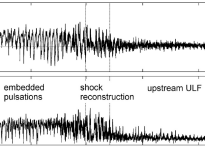
Collisionless shocks are abundant in the universe, and they can for example be found both inherently in the solar wind and as bow shocks sunward of planets and comets. The terrestrial bow shock is the closest, most accesible, and most well-studied such object, however, recent planetary missions have made it possible to as look at some of the other planet in our solar system. These new measurements allow us to test and try our understanding in a broader perspective, and within different parameter regimes.
Read more